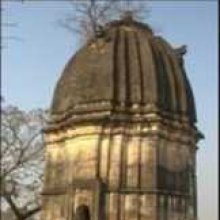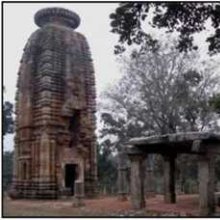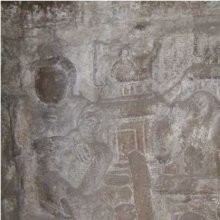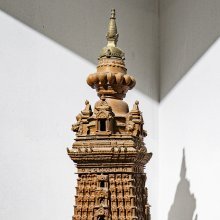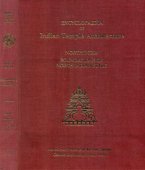Shikhara, Sikhara, Śikhara: 36 definitions
Introduction:
Shikhara means something in Buddhism, Pali, Hinduism, Sanskrit, the history of ancient India, Marathi, Hindi. If you want to know the exact meaning, history, etymology or English translation of this term then check out the descriptions on this page. Add your comment or reference to a book if you want to contribute to this summary article.
The Sanskrit term Śikhara can be transliterated into English as Sikhara or Shikhara, using the IAST transliteration scheme (?).
Alternative spellings of this word include Shikhar.
Images (photo gallery)
In Hinduism
Natyashastra (theatrics and dramaturgy)
Source: Wisdom Library: Nāṭya-śāstraŚikhara (शिखर, “peak”) refers to a gesture (āṅgika) made with a ‘single hand’ (asaṃyuta), according to the Nāṭyaśāstra chapter 8. The hands (hasta) form a part of the human body which represents one of the six major limbs (aṅga) used in dramatic performance. With these limbs are made the various gestures (āṅgika), which form a part of the histrionic representation (abhinaya).
Source: archive.org: The mirror of gesture (abhinaya-darpana)One of the Twenty-eight Single Hands (hasta):—Śikhara (spire): in the same hand, the thumb is raised. Usage: the God of Love (Madan), bow, pillar, silence, husband, tooth,entering, questioning, the body, saying “No!”, recollection, intimate suggestion (ahhinayāntara) , untying the girdle, embrace, lover, letting fly śakti and tomara weapons, sound of abell, pounding.
According to another book: same definition. It originates from Candraśekhara (Śiva), when he held Mt. Meru as his bow. It originates from that Meru-bow, its sage is Jihna, its race Gandharva, its colour dusky, the God of Love (Rati-vallabha) itspatron deity. Usage: gratifying the ancestors, steadiness, establishing a family, hero, spire, friend, cleaning the teeth with to and fro movement, plying a palmyra fan, difference, saying “What?”, drinking water from a spouted vessel (bhṛṅgāra), thenumber four, letting fly śakti or tomara weapons, enjoying consequences, demure attitude of an amorous girl, bashfulness,bow, the God of Love (Smara), saying " No ! ", charity, permanentmood (sthayi-bhāva), Vināyaka, Mahiṣa-mardinī, heroism, galloping of a horse, half-moon, brow-spot, etc., making the signof the hair-knot, sapphire, intensity.
Source: archive.org: Natya ShastraŚikhara (शिखर, “peak”).—A type of gesture (āṅgika) made with a single hand (asaṃyuta-hasta);—(Instructions): In this very hand (muṣṭi) the thumb raised.
(Uses): It is used to represent reins, whip, goad, bow, throwing a javelin (tomara) or a spike *(śakti), painting the two lips and feet and raising up hairs.
Source: Shodhganga: Elements of Art and Architecture in the Trtiyakhanda of the Visnudharmottarapurana (natya)Śīkhara (शीखर) refers to one of the twenty-two Asaṃyuktahastas or “single hand gestures” (in Indian Dramas), according to the Viṣṇudharmottarapurāṇa, an ancient Sanskrit text which (being encyclopedic in nature) deals with a variety of cultural topics such as arts, architecture, music, grammar and astronomy.—The hasta-mudrās (lit. “hand-gestures”) are very essential to denote some particular action or state in dancing and these mudrās are formed with the help of hands and fingers.—The word śīkhara means the peak of a mountain. The Viṣṇudharmottarapurāṇa states that in śīkhara-hasta, the thumb is lifted in the position of a fist. This posture is used to hold rein, goad and bow. According to the Nāṭyaśāstra, apart from holding rein, goad and bow this posture is used to represent the acting of painting of lips and feet. According to the Nāṭyaśāstra, to show the raising up of hairs, this posture is adopted

Natyashastra (नाट्यशास्त्र, nāṭyaśāstra) refers to both the ancient Indian tradition (shastra) of performing arts, (natya—theatrics, drama, dance, music), as well as the name of a Sanskrit work dealing with these subjects. It also teaches the rules for composing Dramatic plays (nataka), construction and performance of Theater, and Poetic works (kavya).
Vaishnavism (Vaishava dharma)
Source: ISKCON Press: GlossaryŚikhara (शिखर).—Curved temple tower or spire. The roof of the sanctum sanctorum. It is crowned by a cakra in a Lord Viṣṇu temple and a trident in a Lord Śiva temple

Vaishnava (वैष्णव, vaiṣṇava) or vaishnavism (vaiṣṇavism) represents a tradition of Hinduism worshipping Vishnu as the supreme Lord. Similar to the Shaktism and Shaivism traditions, Vaishnavism also developed as an individual movement, famous for its exposition of the dashavatara (‘ten avatars of Vishnu’).
Purana and Itihasa (epic history)
Source: Cologne Digital Sanskrit Dictionaries: The Purana IndexŚikhara (शिखर).—A varṣa round the Candra hill of Plakṣa.*
- * Vāyu-purāṇa 49. 14.

The Purana (पुराण, purāṇas) refers to Sanskrit literature preserving ancient India’s vast cultural history, including historical legends, religious ceremonies, various arts and sciences. The eighteen mahapuranas total over 400,000 shlokas (metrical couplets) and date to at least several centuries BCE.
Vastushastra (architecture)
Source: Wisdom Library: Vāstu-śāstraŚikhara (शिखर) refers to the “cupola” of a temple (prāsāda or vimāna). It is considered the fifth part in the ṣaḍvarga structure.
Source: Google Books: Indian Temple Architecture: Form and TransformationŚikhara (शिखर).—A type of moulding;—Any roof form may be called a ‘śikhara’, a term used for the main dome of a vimāna. It is important not to confuse this Southern usage with the Northern, in which ‘śikhara’ is used for tre whole sperstructure of a temple, not just its crown.
Source: Shodhganga: Temples of Salem region Up to 1336 ADŚikhara (शिखर) is the most important member of the prāsāda assembly. It corresponds to the “head” of the body of the temple. On plan it may be caturaśra (square), āyata (rectangular), aṣṭāśra (octagonal), vṛtta (circular), vṛttāyata (oval), gajapṛṣṭa (apsidal) or even āyatavṛtta (rectangular with its two narrower ends made semicircular). Śikhara may be monolithic or masonry in nature. The bottom of the śikhara is always flat.
Source: Knowledge Traditions & Practices of India: Architecture (1): Early and Classical ArchitectureŚikhara (शिखर, “tower”) refers to a common concept found in the ancient Indian “science of architecture” (vāstuvidyā).—Śikhara (for north Indian temples) or vimāna (for south Indian temple) is the tower over the garbhagṛha.
Source: OpenEdition books: Architectural terms contained in Ajitāgama and RauravāgamaŚikhara (शिखर) refers to “roof (5th level of the elevation) §§ 3.12, 27, 28, 31; 4.6, 18.”.—(For paragraphs cf. Les enseignements architecturaux de l'Ajitāgama et du Rauravāgama by Bruno Dagens)
Source: Shodhganga: Elements of Art and Architecture in the Trtiyakhanda of the Visnudharmottarapurana (vastu)1) Śikhara (शिखर) refers to the “topmost” part of the Hindu Temple, according to the Viṣṇudharmottarapurāṇa, an ancient Sanskrit text which (being encyclopedic in nature) deals with a variety of cultural topics such as arts, architecture, music, grammar and astronomy.—Śikhara means the topmost part of a temple which can be said as a spherical roof rising like an inverted cup over a circular base. According to the Viṣṇudharmottarapurāṇa, the śikhara of the temple should be decorated with various figures and it should not be skull-shaped or pointed. Moreover, śikharas are also adorned with āmalakasārakas. The temples of Bhubanesvar, Puri, Konark, Assam etc., are seen to be adorned with beautiful āmalakasārakas in their śikharas.
2) Śikhara (शिखर) refers to one of the hundred types of Temples (in ancient Indian architecture).—It is quite difficult to say about a definite number of varieties of Hindu temples but in the Viṣṇudharmottarapurāṇa hundred varieties of temples have been enumerated. For example, Śikhara. These temples are classified according to the particular shape, amount of storeys and other common elements, such as the number of pavilions, doors and roofs.

Vastushastra (वास्तुशास्त्र, vāstuśāstra) refers to the ancient Indian science (shastra) of architecture (vastu), dealing with topics such architecture, sculpture, town-building, fort building and various other constructions. Vastu also deals with the philosophy of the architectural relation with the cosmic universe.
Kavya (poetry)
Source: Wisdom Library: KathāsaritsāgaraŚikhara (शिखर) is the name of a merchant (vaṇij) from Lampā, according to the Kathāsaritsāgara, chapter 67. Accordingly as Candrasāra said to Naravāhanadatta: “... one day I saw, at a spring festival in a garden, a handsome girl, the daughter of a merchant named Śikhara. I was quite carried off my feet by her, who was like a wave of the sea of love’s insolence, and when I found out who she was, I demanded her in marriage from her father.”.
The Kathāsaritsāgara (‘ocean of streams of story’), mentioning Śikhara, is a famous Sanskrit epic story revolving around prince Naravāhanadatta and his quest to become the emperor of the vidyādharas (celestial beings). The work is said to have been an adaptation of Guṇāḍhya’s Bṛhatkathā consisting of 100,000 verses, which in turn is part of a larger work containing 700,000 verses.

Kavya (काव्य, kavya) refers to Sanskrit poetry, a popular ancient Indian tradition of literature. There have been many Sanskrit poets over the ages, hailing from ancient India and beyond. This topic includes mahakavya, or ‘epic poetry’ and natya, or ‘dramatic poetry’.
Ayurveda (science of life)
Nighantu (Synonyms and Characteristics of Drugs and technical terms)
Source: Wisdom Library: Raj Nighantu1) Śikhara (शिखर) refers to “peak” or “summit” of a mountain (giri) according to the second chapter (dharaṇyādi-varga) of the 13th-century Raj Nighantu or Rājanighaṇṭu (an Ayurvedic encyclopedia). The Dharaṇyādi-varga covers the lands, soil, mountains [viz., Śikhara], jungles and vegetation’s relations between trees and plants and substances, with their various kinds.
2) Śikhara (शिखर) refers to the “end part” of a tree or a creeper, as mentioned in a list of four synonyms, according to the second chapter (dharaṇyādi-varga) verse 2.32.

Āyurveda (आयुर्वेद, ayurveda) is a branch of Indian science dealing with medicine, herbalism, taxology, anatomy, surgery, alchemy and related topics. Traditional practice of Āyurveda in ancient India dates back to at least the first millenium BC. Literature is commonly written in Sanskrit using various poetic metres.
Shilpashastra (iconography)
Source: Shodhganga: The significance of the mūla-beras (śilpa)1) Śikhara (शिखर) refers to the “spire/tower” of the Hindu temple.—The temple contains the sanctuary known as vimāna or towered sanctuary. Over the vimāna is the śikhara or the spire/tower. The topmost part of the śikhara, whose sloping walls lead towards a point, is the stūpi or the finial or the apex.
2) Śikhara (शिखर) or Śikharahasta refers to “bow-hold, crest” and represents one of the twenty-four gestures with a single hand, as defined according to texts dealing with śilpa (arts and crafs), known as śilpaśāstras.—Accordingly, pratimā-lakṣaṇa (body postures of the icons) is comprised of hand gestures (hasta, mudrā or kai-amaiti), stances/poses (āsanas) and inflexions of the body (bhaṅgas). There are thirty-two types of hands [viz., śikhara-hasta] classified into two major groups known as tolirkai (functional and expressive gestures) and elirkai (graceful posture of the hand).

Shilpashastra (शिल्पशास्त्र, śilpaśāstra) represents the ancient Indian science (shastra) of creative arts (shilpa) such as sculpture, iconography and painting. Closely related to Vastushastra (architecture), they often share the same literature.
Shaivism (Shaiva philosophy)
Source: academia.edu: Religious Inclusivism in the Writings of an Early Modern Sanskrit Intellectual (Shaivism)Śikhara (शिखर) or Śrutiśikhara refers to the “foremost (scriptures)”.—Not only does Appaya believe that Advaita is the underlying teaching of Śrīkaṇṭha’s commentary; he also takes it to be the final word of all Śaivāgamas and actually of all Hindu scriptures, as he himself solemnly declares at the beginning of the Śivārkamaṇidīpikā: “The culminating point (niṣṭhā) of the words of the foremost scriptures [i.e., śruti-śikhara-girā], āgamas as well as all [other] compositions, from the multitude of Purāṇas to smṛti texts such as the Mahābhārata and so forth, is in non-duality alone (advaita eva); the Brahmasūtras too appear to the discerning ones to have their rest in [non-duality] alone [and] nothing but that [non-duality] was accepted by ancient ācāryaratnas led by Śaṅkara”
Source: SOAS University of London: Protective Rites in the Netra TantraŚikhara (शिखर) refers to the “turret (of a palace)”, according to the Svacchanda-tantra.—Accordingly, [verse 4.8-13, while describing auspicious dreams]—“[The dreamer] crosses over the ocean and river. Likewise sunrise and indeed blazing fire [are auspicious. Also auspicious is when the dreamer] sees planets, constellations, stars and the disk of the moon. [When the dreamer] ascends the palace or a turret of the palace (prāsāda-śikhara), climbs a mountain top, tree, elephant, young animal, bull, horse, or man. [In auspicious dreams one] sees a chariot and also sees the siddhamantra, obtains the perfected oblation and sees the gods, etc. [...]”

Shaiva (शैव, śaiva) or Shaivism (śaivism) represents a tradition of Hinduism worshiping Shiva as the supreme being. Closely related to Shaktism, Shaiva literature includes a range of scriptures, including Tantras, while the root of this tradition may be traced back to the ancient Vedas.
Jyotisha (astronomy and astrology)
Source: Wisdom Library: Brihat Samhita by VarahamihiraŚikhara (शिखर) refers to the “tops of mountains”, according to the Bṛhatsaṃhitā (chapter 3), an encyclopedic Sanskrit work written by Varāhamihira mainly focusing on the science of ancient Indian astronomy astronomy (Jyotiṣa).—Accordingly, “The dark spots, also known as ketus, the sons of Rāhu are Tāmasa, Kīlaka and the like, and are 33 in number. How they affect the earth depends upon their color, position and shape. [...] When the spots appear on the solar disc the waters will get disturbed; the sky will be filled with dust; high winds capable of breaking down the tops of mountains [i.e., śikhara] and of trees, will carry pebbles and sand along their course”.

Jyotisha (ज्योतिष, jyotiṣa or jyotish) refers to ‘astronomy’ or “Vedic astrology” and represents the fifth of the six Vedangas (additional sciences to be studied along with the Vedas). Jyotisha concerns itself with the study and prediction of the movements of celestial bodies, in order to calculate the auspicious time for rituals and ceremonies.
Sports, Arts and Entertainment (wordly enjoyments)
Source: archive.org: Syainika Sastra of Rudradeva with English Translation (art)Śikhara (शिखर) refers to the “top (of a lofty building)” (suitable for keeping hawks), according to the Śyainika-śāstra: a Sanskrit treatise dealing with the divisions and benefits of Hunting and Hawking, written by Rājā Rudradeva (or Candradeva) in possibly the 13th century.—Accordingly, [while discussing the treatment of hawks]: “Hawks should be kept tied in a quiet place on the top of a lofty building (prāsāda-śikhara), beautifully whitewashed and cooled with sprays of water by means of machines; fans should be moved gently and at intervals, by men placed at a distance ; and the place should be kept free from flies by means of netted windows”.

This section covers the skills and profiencies of the Kalas (“performing arts”) and Shastras (“sciences”) involving ancient Indian traditions of sports, games, arts, entertainment, love-making and other means of wordly enjoyments. Traditionally these topics were dealt with in Sanskrit treatises explaing the philosophy and the justification of enjoying the pleasures of the senses.
General definition (in Hinduism)
Source: archive.org: Vedic index of Names and SubjectsŚikhara (शिखर) as a ‘peak’ of a mountain is found in the Kauṣītaki-brāhmaṇa (xxvi. 1), and often in the Epic.
In Buddhism
Mahayana (major branch of Buddhism)
Source: De Gruyter: A Buddhist Ritual Manual on AgricultureŚikhara (शिखर) refers to the “(Vajra) pinnacle” [i.e., vajraśikharatuṇḍe], [as mentioned in the Vajra-beak dhāraṇī taught by the Garuḍa-king], according to the Vajratuṇḍasamayakalparāja, an ancient Buddhist ritual manual on agriculture from the 5th-century (or earlier), containing various instructions for the Sangha to provide agriculture-related services to laypeople including rain-making, weather control and crop protection.

Mahayana (महायान, mahāyāna) is a major branch of Buddhism focusing on the path of a Bodhisattva (spiritual aspirants/ enlightened beings). Extant literature is vast and primarely composed in the Sanskrit language. There are many sūtras of which some of the earliest are the various Prajñāpāramitā sūtras.
India history and geography
Source: Cologne Digital Sanskrit Dictionaries: Indian Epigraphical GlossaryŚikhara.—(SITI; CITD), top portion of the turret built over the main shrine and the gateway of a temple; the top of the gopura or vimāna of a temple. Note: śikhara is defined in the “Indian epigraphical glossary” as it can be found on ancient inscriptions commonly written in Sanskrit, Prakrit or Dravidian languages.

The history of India traces the identification of countries, villages, towns and other regions of India, as well as mythology, zoology, royal dynasties, rulers, tribes, local festivities and traditions and regional languages. Ancient India enjoyed religious freedom and encourages the path of Dharma, a concept common to Buddhism, Hinduism, and Jainism.
Languages of India and abroad
Pali-English dictionary
Source: BuddhaSasana: Concise Pali-English Dictionarysikhara : (nt.) the top; summit; peak of a mountain.
Source: Sutta: The Pali Text Society's Pali-English DictionarySikhara, (cp. Sk. śikhara) the top, summit of a mountain J. VI, 519; Miln. 2; a peak DhA. III, 364 (°thūpiyo or °thūpikāyo peaked domes); the point or edge of a sword M. I, 243; S. IV, 56; crest, tuft J. II, 99; (this is a very difficult reading; it is explained by the C. by sundara (elegant); Trenckner suggests singāra, cp. II. 98); a bud Th. 2, 382. (Page 708)

Pali is the language of the Tipiṭaka, which is the sacred canon of Theravāda Buddhism and contains much of the Buddha’s speech. Closeley related to Sanskrit, both languages are used interchangeably between religions.
Marathi-English dictionary
Source: DDSA: The Molesworth Marathi and English Dictionaryśikhara (शिखर).—n (S) The peak or summit of a mountain; the top or extremity of a tree, pointed building &c.; apex, vertex, top, or crest generally. 2 A spire or pinnacle; a minaret. 3 fig. The pinnacle, acme, culmen (as of greatness, of any virtue or vice): the conclusion or terminating point (of a business). śikharīṃ kāṭhyā lāgaṇēṃ (Because at jējurī or at maḍhī the followers of Khanḍoba proceed in formal procession with music &c. to Khanḍoba's temple, and apply long kāṭhyā or poles with flags or cloths to its crest or summit.) To accomplish one's undertaking; to attain the pinnacle, goal, crown, consummation. śikharīṃ pōṭa lāgaṇēṃ (The belly to swell so as to reach the head.) To become very distended;--as the belly through gorging or disease, as the womb through pregnancy.
Source: DDSA: The Aryabhusan school dictionary, Marathi-Englishśikhara (शिखर).—n The peak of a mountain, a top generally. A spire. Fig. The pinnacle. The conclusion.
Marathi is an Indo-European language having over 70 million native speakers people in (predominantly) Maharashtra India. Marathi, like many other Indo-Aryan languages, evolved from early forms of Prakrit, which itself is a subset of Sanskrit, one of the most ancient languages of the world.
Sanskrit dictionary
Source: DDSA: The practical Sanskrit-English dictionaryŚikhara (शिखर).—[śikhā astyasya-arac ālopaḥ]
1) The top, summit, or peak of a mountain; जगाम गौरी शिखरं शिखण्डिमत् (jagāma gaurī śikharaṃ śikhaṇḍimat) Kumārasambhava 5.7,4; Meghadūta 18.
2) The top of a tree.
3) Crest, tuft.
4) The point or edge of a sword.
5) Top, peak, point in general.
6) The arm-pit.
7) Bristling of the hair.
8) The bud of the Arabian jasmine.
9) A kind of ruby-like gem.
-rā Name of a plant. (mūrvā).
Derivable forms: śikharaḥ (शिखरः), śikharam (शिखरम्).
Source: Cologne Digital Sanskrit Dictionaries: Shabda-Sagara Sanskrit-English DictionaryŚikhara (शिखर).—mn.
(-raḥ-raṃ) 1. The peak or summit of a mountain. 2. The top of a tree. 3. Point, end, top in general. 4. Horripilation. 5. The armpit. 6. A piece of a ruby or a gem, described as of the colour of the ripe pomegranate seed or a bright red. 7. The bud of the Arabian jasmine. 8. The edge or point of a sword. f.
(-rā) A plant, from the fibres of which bow-strings were made, (Sanseviera zeylanica.) E. śikhā a crest, and rac poss. aff., and the vowel made short.
Source: Cologne Digital Sanskrit Dictionaries: Benfey Sanskrit-English DictionaryŚikhara (शिखर).— (cf. śikhā), m. and n. 1. Summit, [Pañcatantra] 9, 7; end. 2. The summit of a mountain, [Bhartṛhari, (ed. Bohlen.)] 2, 91; [Vikramorvaśī, (ed. Bollensen.)] 10, 6. 3. The top of a tree. 4. The edge or a point of a sword. 5. Horripilation. 6. The armpit. 7. A gem of a bright red colour; the bud of the Arabian jasmine, [Meghadūta, (ed. Gildemeister.)] 80 (Sch.).
Source: Cologne Digital Sanskrit Dictionaries: Cappeller Sanskrit-English DictionaryŚikhara (शिखर).—[adjective] peaked; [masculine] [neuter] peak, top, summit.
Source: Cologne Digital Sanskrit Dictionaries: Monier-Williams Sanskrit-English Dictionary1) Śikhara (शिखर):—a etc. See [column]3.
2) [from śikhā] b mfn. pointed, spiked, crested, [Meghadūta; Kathāsaritsāgara]
3) [v.s. ...] m. n. a point, peak (of a mountain), top or summit (of a tree), edge or point (of a sword), end, pinnacle, turret, spire, [Mahābhārata; Kāvya literature] etc.
4) [v.s. ...] m. erection of the hair of the body, [cf. Lexicographers, esp. such as amarasiṃha, halāyudha, hemacandra, etc.]
5) [v.s. ...] the arm-pit, [cf. Lexicographers, esp. such as amarasiṃha, halāyudha, hemacandra, etc.]
6) [v.s. ...] a ruby-like gem (of a bright red colour said to resemble ripe pomegranate seed), [cf. Lexicographers, esp. such as amarasiṃha, halāyudha, hemacandra, etc.]
7) [v.s. ...] (?) the bud of the Arabian jasmine (cf. -daśanā)
8) [v.s. ...] Name of a mythical weapon (astra), [Rāmāyaṇa]
9) [v.s. ...] a [particular] position of the fingers of the hand, [Catalogue(s)]
10) [v.s. ...] Name of a man, [Kathāsaritsāgara]
11) Śikharā (शिखरा):—[from śikhara > śikhā] f. Sanseviera Roxburghiana (a plant from the fibres of which bow-strings are made), [cf. Lexicographers, esp. such as amarasiṃha, halāyudha, hemacandra, etc.]
12) [v.s. ...] Name of a [particular] mythical club (gadā), [Rāmāyaṇa]
13) Śikhara (शिखर):—[from śikhā] n. cloves, [cf. Lexicographers, esp. such as amarasiṃha, halāyudha, hemacandra, etc.]
Source: Cologne Digital Sanskrit Dictionaries: Yates Sanskrit-English DictionaryŚikhara (शिखर):—[(raḥ-raṃ)] 1. m. n. The peak or summit of a mountain; the top; end; horripilation; edge of a sword; arm-pit; ruby. 1. f. A plant from which bow-strings are made.
Source: DDSA: Paia-sadda-mahannavo; a comprehensive Prakrit Hindi dictionary (S)Śikhara (शिखर) in the Sanskrit language is related to the Prakrit word: Sihara.
[Sanskrit to German]
Sanskrit, also spelled संस्कृतम् (saṃskṛtam), is an ancient language of India commonly seen as the grandmother of the Indo-European language family (even English!). Closely allied with Prakrit and Pali, Sanskrit is more exhaustive in both grammar and terms and has the most extensive collection of literature in the world, greatly surpassing its sister-languages Greek and Latin.
Hindi dictionary
Source: DDSA: A practical Hindi-English dictionaryŚikhara (शिखर) [Also spelled shikhar]:—(nm) a peak, top, summit, pinnacle; vortex, apex; -[sammelana] a summit conference.
...
Kannada-English dictionary
Source: Alar: Kannada-English corpusŚikhara (ಶಿಖರ):—
1) [noun] the highest point; peak; vertex.
2) [noun] the peak of a mountain.
3) [noun] the top portion of a tree.
4) [noun] the tower on the main entrance of a temple.
5) [noun] (dance.) a posture of the hands, in which all the four fingers are folded into the palm and the thumb erected and made to point upward.
--- OR ---
Sikhara (ಸಿಖರ):—[noun] = ಸಿಕರ [sikara].
--- OR ---
Sikhāra (ಸಿಖಾರ):—[noun] = ಸಿಕರ [sikara].
Kannada is a Dravidian language (as opposed to the Indo-European language family) mainly spoken in the southwestern region of India.
See also (Relevant definitions)
Starts with (+4): Shikhara-sammelana, Shikhara-varta, Shikharabha, Shikharadashana, Shikharadati, Shikharadatta, Shikharadhara, Shikharadri, Shikharagira, Shikharahasta, Shikharaja, Shikharalakshana, Shikharamani, Shikharana, Shikharane, Shikharanicaya, Shikharapurisa Janem, Shikharasena, Shikharasvamin, Shikharasvamini.
Ends with (+26): Arbudashikhara, Astashikhara, Atavishikhara, Bahushikhara, Bhujashikhara, Candrakumarashikhara, Dashanashikhara, Dohshikhara, Dosshikhara, Dvishikhara, Gaurishikhara, Gayashikhara, Girisikhara, Gokshiravarashikhara, Himadrishikhara, Himashikhara, Himavacchikhara, Jihvashikhara, Jvalantashikhara, Kailasashikhara.
Full-text (+173): Shikharavasini, Sahasrashikhara, Shailashikhara, Vahnishikhara, Atavishikhara, Dohshikhara, Girisikhara, Bahushikhara, Astashikhara, Trishikhara, Vimana, Griva, Bhujashikhara, Stupi, Raghurama, Jvalantashikhara, Pabbatasikhara, Shikharin, Shikharasena, Shikharasvamini.
Relevant text
Search found 39 books and stories containing Shikhara, Sikhara, Śikhara, Śikharā, Sikhāra; (plurals include: Shikharas, Sikharas, Śikharas, Śikharās, Sikhāras). You can also click to the full overview containing English textual excerpts. Below are direct links for the most relevant articles:
Vishnudharmottara Purana (Art and Architecture) (by Bhagyashree Sarma)
8. Characteristic Features of Sarvatobhadra Temple < [Chapter 4 - Temple Building]
5. Different Parts of a Temple < [Chapter 4 - Temple Building]
1.3. Elements of Drama (e): Gatiprasāra (gait extension) < [Chapter 3 - Drama and Dance]
Early Chola Temples (by S. R. Balasubrahmanyam)
Sikhara < [Chapter XIII - Prasada: Component Parts]
Temples in Melpadi < [Chapter IX - Temples of Rajaraja I’s Time]
Temples in Nangavaram (about the 10th year) < [Chapter X - Historical Survey]
Vastu-shastra (5): Temple Architecture (by D. N. Shukla)
Śikharottama Prāsādas (Nāgara Temples)—The evolution of Śikhara < [Chapter 12 - History of Hindu Temples (Prāsādas and Vimānas)]
Temple architecture in Siam (Thailand) < [Chapter 12 - History of Hindu Temples (Prāsādas and Vimānas)]
The Temples of Deccan (1100-1300 A.D.) < [Chapter 12 - History of Hindu Temples (Prāsādas and Vimānas)]
Kashyapa Shilpa-shastra (study) (by K. Vidyuta)
4 (b). Technical terms for the component parts of the temple < [Chapter 2 - Author and his Works]
6. Components in the Storeys of the Gopuras < [Chapter 5 - Gopura Lakṣaṇa]
3. Temple Architecture (Prāsāda or Vimānā) < [Chapter 1 - Introduction]
Temples of Munnur (Historical Study) (by R. Muthuraman)
Sri Kamatchi Amman Shrine < [Chapter 4]
Sri Prakannayagi Amman Shrine < [Chapter 4]
Adavalleswarar or Adavalleeswarar Temple (Architecture) < [Chapter 4]
Samarangana-sutradhara (Summary) (by D. N. Shukla)
Related products
